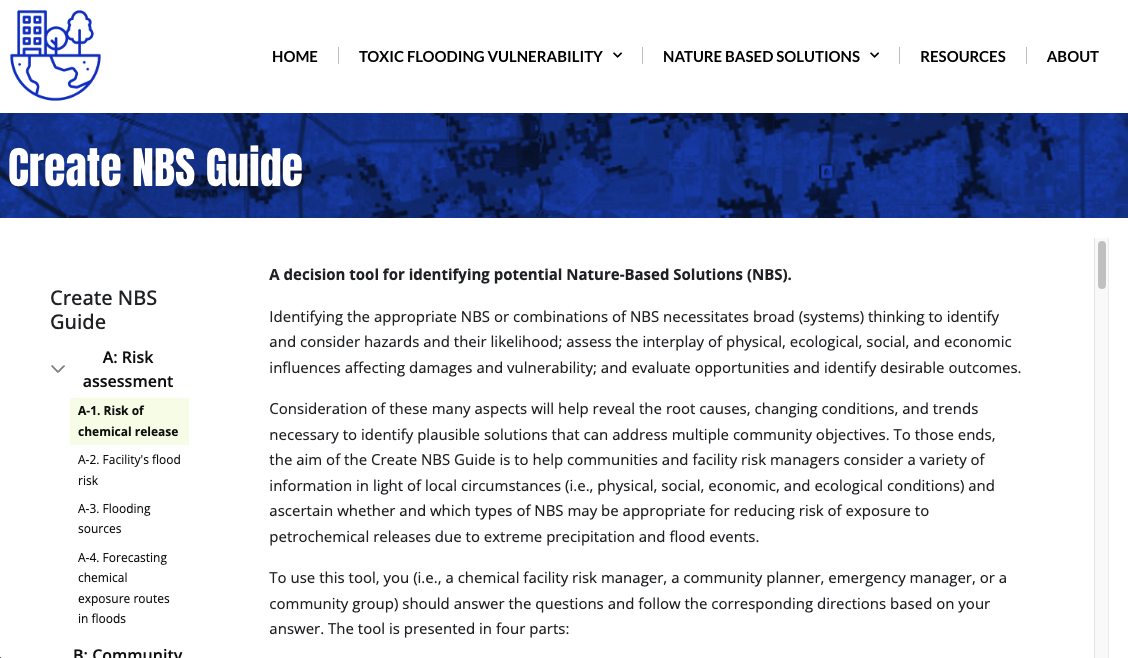How can we use nature to build more resilient communities?
In identifying the appropriate NBS, it is important to consider hazards and their likelihood; assess the interplay of physical, ecological, social, and economic influences affecting damages and vulnerability; and evaluate opportunities and identify desirable outcomes. To assist this process, we developed the Create NBS guide to help communities and facility risk managers determine whether and which types of NBS can help reduce risk of exposure to petrochemical releases due to extreme precipitation and flood events.
The Create NBS guide will guide considerations, facilitate discussion about priorities, identify data needs, and aid selection of one or a suite of nature-based solutions to explore in a subsequent design phase. This tool can and should be applied iteratively — first as an initial qualitative evaluation and later with increasing quantitative input from local community members, academics, and technical experts to better establish feasibility of solutions. Measures and scales are suggested; no weights are assigned (but you may wish to do so).
It is unlikely one person (even an expert!) can answer all these questions. When you or your team cannot answer a question, consider that as an indicator that additional expertise or data will likely be needed to inform decisions.
The tool is a guide — not a cookbook. It is designed to be flexible and provides suggestions to help you adapt the tool to meet your specific needs. It can be completed online or downloaded and modified. A step-by-step walk through of the tool is available here.
Consider how to build community support: The level of risk a community can tolerate can depend to a great extent on socio-economic factors affecting both community-wide and personal vulnerability. Flood prone socio-economically challenged communities often have fewer resources, less flood insurance, and less access to government programs consequently they often take longer to recover from floods. Even, reducing the frequency of relatively small flooding events can realize significant improvement in quality of life in these communities. It is important to build stakeholder understanding of flood probabilities and how changing environmental conditions — from habitat loss to climate change — affects flood probability and the impact of floods. Similarly, it is important that stakeholders gain an understanding that neither NBS nor traditional hardscaped engineering solutions will not work for every conceivable storm event and condition. Beyond what level of uncertainty will the community accept, corollary questions should include: what level of protection is expected from the NBS and will it be considered the principal hazard reduction measure to achieve that level of protection?
Examine how committed the community is to management and maintenance: Periodic maintenance, especially in the initial years after installation, will likely be needed. Ideally NBS will become self-sustaining as well as resilient to storms, given the correct physical and biological settings (e.g., sediment supplies); however, there is always the possibility of needing major repairs after large events to boost recovery speed. Beach nourishment is an NBS that typically requires periodic renourishment due to normal erosion. Furthermore, if conditions change more or differently than planned, adaptive management may be necessary.
Properly constructed NBS should not require extensive repairs after major storms but it is reasonable to plan for the potential for major repair costs if a storm occurs in the initial years after NBS construction. One advantage of NBS is that they tend to grow more stable with age as plants and roots get larger. However where beaches and dune projects provide distance and physical protection to property during major storms, more extensive and costly repair efforts may be required after major storms.
Local public works or recreational department’s staff likely will need training on proper management and maintenance of NBS.
Areas used for passive recreation will need additional management and maintenance (e.g., garbage removal, security, walkway repairs, etc.). Therefore, it is important to consider funding needs for maintenance as well as job creation benefits.
Explore ways to build community commitment to protect NBS. Community based volunteer groups may be able to take responsibility for some management and monitoring tasks. Often academic and research institutions can be encouraged to monitor and report on site conditions and performance.
Finding and dedicating revenue is a challenge for any project from its first idea exploration or feasibility phase, to detained modeling and design, to implementation, and lastly sustained management, monitoring, and potential amendments. Building partnerships will expand funding opportunities. Fortunately, projects involving NBS can benefit by tapping and combining multiple sources of funds such as FEMA flood hazard mitigation grants, NOAA/National Fish and Wildlife Foundation coastal resilience grants, EPA sewer overflow and storm water reuse municipal grants, and many other programs that target habitat and species recovery. Innovative financing options, such as resilience bonds, environmental impact bonds, and parametric insurance are also expanding.
Additional Funding Sources: An ASBPA paper, titled Local Funding for Coastal Projects: An Overview of Practices, Policies, and Considerations presents options for raising revenue and discusses emerging financial tools as well as considerations communities can take into account to determine which may be most appropriate for funding a beach or coastal restoration project.
Financing Natural Infrastructure for Coastal Flood Damage Reduction


